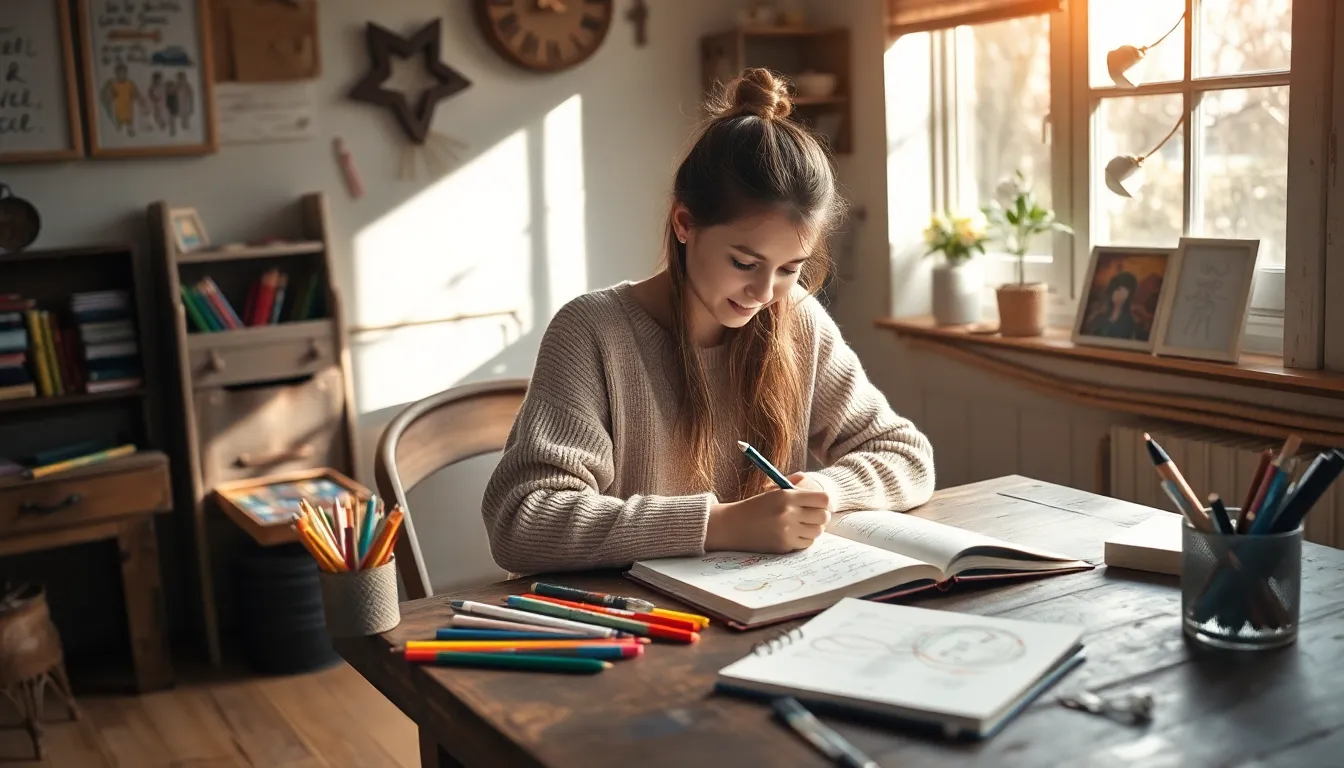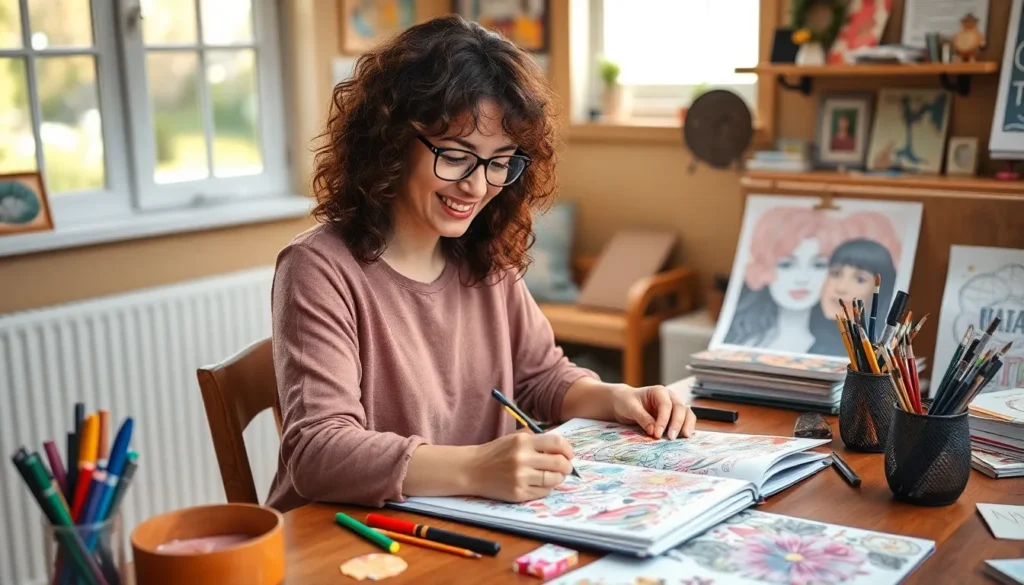Table of Contents
ToggleCreative journaling offers a vibrant outlet for self-expression and reflection. It combines art and writing, allowing individuals to explore their thoughts, feelings, and experiences in a unique way. This practice invites creativity into daily life, transforming blank pages into colorful canvases filled with ideas, sketches, and musings.
In a world that often prioritizes productivity over personal growth, creative journaling provides a refreshing escape. It encourages mindfulness and helps to cultivate a deeper understanding of oneself. Whether through doodling, collage, or free writing, this artful approach to journaling can enhance mental clarity and emotional well-being. Embracing creative journaling might just be the key to unlocking hidden insights and unleashing one’s imagination.
What Is Creative Journaling?
Creative journaling combines art and writing to facilitate self-expression and reflection. This practice empowers individuals to explore their thoughts and feelings in an imaginative and personal manner.
Definition and Purpose
Creative journaling is a versatile method that blends artistic elements with written reflections. The primary purpose lies in fostering personal growth and emotional clarity. Individuals utilize creative journaling to manage stress, gain insights, and enhance mindfulness. By allowing thoughts to flow freely, they cultivate a deeper understanding of themselves, turning abstract emotions into tangible expressions.
Different Forms of Creative Journaling
Various forms of creative journaling cater to diverse preferences and styles. Common examples include:
- Art Journaling: Combines drawing, painting, and mixed media. Participants express feelings through visual art while embedding written reflections.
- Collage Journaling: Involves assembling images, words, and textures from magazines or other sources. This method encourages visual storytelling and thematic exploration.
- Bullet Journaling: Blends organization and creativity. Individuals track tasks, goals, and reflections in a structured yet artistic format.
- Freewriting: Focuses on spontaneous writing without editing. This encourages the flow of ideas and helps individuals articulate thoughts openly.
- Gratitude Journaling: Centers on documenting positive experiences and emotions. Practitioners cultivate appreciation and positivity by reflecting on daily blessings.
These diverse forms allow individuals to tailor their journaling experience, enhancing creativity and personal expression.
Benefits of Creative Journaling

Creative journaling offers numerous advantages, particularly for mental health, emotional clarity, and personal expression. This multifaceted practice encourages individuals to connect with their inner selves through artistic exploration and writing.
Mental Health and Well-Being
Creative journaling significantly enhances mental health. It provides an outlet for individuals to process emotions, reducing anxiety and stress. Engaging with art and writing fosters mindfulness, allowing individuals to remain present and reflective. Research indicates that expressive writing can lower feelings of distress, decrease intrusive thoughts, and contribute to overall emotional balance. For example, writing about daily experiences or emotions can improve mood stability and self-awareness, promoting a healthier mental state.
Enhanced Creativity and Self-Expression
Creative journaling unlocks potential for greater creativity and self-expression. By merging artistic elements, such as doodling and painting, with written reflections, individuals amplify their creative energy. This practice encourages experimentation and exploration, allowing for personal styles and preferences to flourish. Engaging in various forms of journaling supports the discovery of unique ideas, enhancing problem-solving skills and imaginative thinking. A study found that individuals who engage in creative outlets often report higher levels of innovation in both personal and professional spheres.
How to Get Started with Creative Journaling
Starting creative journaling involves selecting suitable materials and exploring various techniques. Engaging in this practice can enhance personal expression and foster creativity.
Choosing the Right Materials
Selecting materials plays a crucial role in creative journaling. Consider the following options:
- Journals: Opt for blank, lined, or mixed-media journals that suit personal preferences.
- Writing Tools: Use pens, pencils, markers, or colored pencils to express ideas vividly.
- Art Supplies: Incorporate watercolors, acrylics, washi tape, and stickers for added creativity.
- Collage Elements: Collect magazines, photographs, and printed images for visual storytelling.
Experimenting with different combinations encourages experimentation and enhances the journaling experience.
Techniques and Prompts
Employing diverse techniques and prompts stimulates creativity. The following techniques can enhance one’s journaling practice:
- Doodling: Integrate simple sketches alongside written reflections for visual engagement.
- Mind Mapping: Create diagrams that visually organize thoughts and ideas.
- Affirmations: Write positive statements to inspire motivation and self-empowerment.
- Prompts: Use prompts such as “What am I grateful for today?” or “What inspires me?” to spark creativity and reflection.
Regular practice of these techniques enables individuals to unlock deeper insights and cultivate a better understanding of their thoughts and emotions.
Tips for Maintaining a Creative Journaling Habit
Establishing a regular creative journaling practice enhances its benefits and ensures sustained engagement. Implementing effective strategies can facilitate this ongoing relationship with journaling.
Setting a Routine
Setting a consistent time each day for creative journaling fosters habit formation. Morning or evening sessions allow for reflection and creativity when the mind is most receptive. Committing to specific durations, such as 10-30 minutes, can help maintain focus and encourage writings. Keeping the journaling space organized and inviting also enhances the likelihood of returning to it consistently. Utilizing reminders, such as calendar alerts or app notifications, can prompt participants to create this essential time for self-exploration.
Overcoming Creative Blocks
Overcoming creative blocks during journaling requires some effective approaches. Engaging in freewriting, where one writes continuously without concern for structure or grammar, can help bypass mental barriers. Changing mediums, such as switching from writing to drawing or using different colors, can spark new ideas and perspectives. Incorporating prompts or questions that challenge thinking and reflection also ignites creativity. Taking breaks and stepping away for a short walk can refresh the mind, making it easier to return with renewed inspiration.
Utilizing these tips can enhance the overall experience of creative journaling and cultivate a fulfilling habit that enriches both personal expression and emotional clarity.
Creative journaling offers a transformative path for self-discovery and emotional clarity. By blending artistic expression with reflective writing, it invites individuals to explore their innermost thoughts and feelings. This versatile practice not only enhances creativity but also promotes mental well-being.
Establishing a routine can lead to profound insights and personal growth. With various techniques and materials at their disposal, anyone can find a unique approach that resonates with them. Embracing creative journaling can unlock new perspectives and foster a deeper understanding of oneself, making it a valuable tool for navigating life’s complexities.




